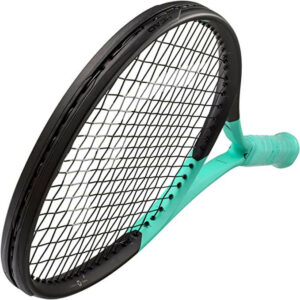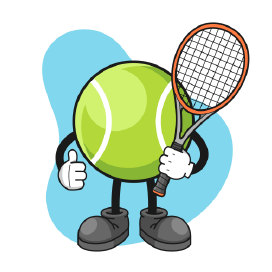When selecting the best tennis racket for your game, it is important to familiarize yourself with the different parts that make up a tennis racket.
The main components of a tennis racket include:
- Head.
- Strings.
- Handle.
- Throat.
- Butt cap.
In this article we will go into detail about all the parts of the tennis racket, to help you choose the best one for your game.
Get to Know Your Racquet: Breaking Down the Parts of a Tennis Racket
Save time with this video: Breaking down the Parts of a Tennis Racket
Head
The head of the racket is the main striking surface and is usually made from graphite, aluminum, or a combination of both. This is where you’ll be hitting the ball and creating spin. The size of the head will determine the power, control, and stability you get from your shots.

Strings
The strings are a thin material which connects the head to each other. Strings come in a variety of materials including synthetic gut, polyester, nylon and multi-filaments such as Kevlar or co-polymer. Different string tensions and patterns will create different levels of control, durability and feel.

Handle
The handle is where you grip your racket and is usually made from wood or graphite composite. It’s important to make sure that the grip fits comfortably in your hand and provides enough cushion for shocks when playing. Having an appropriate handle size will also help you to generate more power when you swing.

Throat
The throat of a tennis racket is the area where the head and handle of the racket meet. It is usually made of a sturdy material such as aluminum or carbon fiber. The throat may be open or closed. An open throat splits into two sections and extends outward to begin the formation of the head, while a closed throat is solid and does not split. Most modern racquets have open throats, while older wooden racquets often have closed throats. The throat of a racket plays a crucial role in the overall balance and stability of the racket.

Butt Cap
The butt cap is usually made from rubber, plastic or metal and is located at the bottom of the handle. The endcap provides cushioning in order to reduce shock on your arm during play as well as giving you more leverage when swinging the racket.
With all these parts making up a tennis racket, it can be difficult to decide which one best suits your playing style and ability level. However, if you have knowledge about each part of the racket, you can make an informed decision on the best tennis racket for your game.

Shaft
The shaft is the section of the racket that connects the head and handle, it determines your control and power. Most modern rackets have an aerodynamic design which helps to generate more power when you swing. The best way to find the best racket for you is to try out different shapes and sizes to find what best suits your style.

Bumper guard
A bumper guard, also known as a grommet strip or guard tape, is a protective material that wraps around the head of the racket. This helps to protect the strings and frame when playing. Bumper guards are usually made from rubber or plastic and come in different shapes, sizes and colors.

Grommets
Grommets are the small plastic rings that hold the strings in place. They help to keep the tension of the strings even and also reduce friction when they make contact with each other, providing a better playing experience.

Benefits of Replacing Worn-Out Tennis Racquet Parts
Replacing worn-out tennis racquet parts is an essential aspect of maintaining the performance and longevity of your racquet. Here are some of the benefits of replacing worn-out tennis racquet parts:
- Improved Performance: Worn-out parts such as strings, grips, and dampeners can significantly affect the performance of your tennis racquet. Replacing these parts can help restore your racquet’s original feel and responsiveness, allowing you to hit your shots with greater accuracy and power.
- Enhanced Comfort: As tennis racquet parts wear out, they can become uncomfortable to use, causing pain and discomfort in your hands and arms. By replacing worn-out grips and dampeners, you can improve the comfort of your racquet, making it easier to play for extended periods without experiencing discomfort.
- Increased Durability: Tennis racquet parts such as strings and grommets are subject to wear and tear during play, and if left unattended, can lead to permanent damage to your racquet. Replacing these parts at regular intervals can help increase the durability of your racquet and extend its overall lifespan.
- Customization: By replacing worn-out tennis racquet parts, you can also customize your racquet to suit your playing style and preferences. Upgrading your strings, for instance, can give you more spin and control, while a new grip can provide a better feel for your shots.
- Cost Savings: While it may seem like an expense to replace worn-out tennis racquet parts, it can actually be a cost-saving measure in the long run. Regular maintenance can help prevent more significant problems from occurring, which can save you the cost of having to buy a new racquet altogether.
Replacing worn-out tennis racquet parts is an essential aspect of maintaining the performance and longevity of your racquet.
Exploring Different Types of Racquet Strings
The type of string used on a tennis racquet can significantly impact a player’s game. Strings come in different materials, gauges, and tensions, each with its unique characteristics. Here are some of the different types of racquet strings available:
Synthetic Gut:
This is the most popular type of string used by tennis players. It is made from a blend of nylon and other synthetic materials and is relatively inexpensive compared to other types of strings. Synthetic gut offers a good balance of power, control, and durability.
Multifilament:
Multifilament strings are made up of several hundred strands of fiber woven together. They offer excellent power, comfort, and feel but are not as durable as the synthetic gut.
Natural Gut:
Natural gut strings are made from the intestines of cows or sheep. They offer the best feel, power, and control but are also the most expensive and least durable.
Polyester:
Polyester strings are popular with players who hit the ball hard and fast. They offer excellent control and durability but are stiff and can cause arm fatigue and discomfort.
Kevlar:
Kevlar strings are the most durable strings available and are often used by players who break strings frequently. However, they are stiff and can cause arm fatigue and discomfort.
Hybrid:
Hybrid strings are a combination of two different types of strings, typically a natural gut or multifilament string in the mains and a polyester string in the crosses. This combination offers a good balance of power, comfort, and durability.
Frequently Asked Question
The top part of a tennis racket is called the head. The head is where you hit the ball and it’s usually made from graphite, aluminum, or a combination of both.
Different sizes and shapes of the head can determine your power, control, and stability when playing. The best way to find the best racket for you is to try out different sizes and shapes to see what best suits your style.
The five main components of a tennis racket are the head, strings, handle, throat and butt cap.
The little things on tennis rackets are called grommets. Grommets are small plastic rings that hold the strings in place and keep their tension even. They also reduce friction when they make contact with each other, providing a better playing experience.
The shaft is the section of the racket that connects the head and handle, it helps to determine your control and power when you hit the ball. Most modern rackets have an aerodynamic design which helps to generate more power when you swing. The best way to find the best racket for you is to try out different shapes and sizes to find what best suits your style.
The handle is the section of the racket that you grip and it’s usually made from wood or graphite composite. It’s important to make sure that the grip fits comfortably in your hand and provides enough cushion for shocks when playing. Having an appropriate handle size will also help you to generate more power when you swing.
The sweet spot is the best part of the strings to hit the ball with. It’s usually located near the center of the racket head and helps to produce more power when striking the ball.
You can find your own sweet spot by experimenting with different parts of the racket head until you find an area that produces the best results for you.
A spike in tennis is commonly known as a “volley” or “swipe” shot. It’s an offensive move that involves hitting the ball before it bounces on your side of the court, typically done when you’re close to the net. Volleys are used to quickly hit powerful shots and surprise your opponent.
A bumper guard, also known as a grommet strip or guard tape, is a protective material that wraps around the head of the racket. This helps to protect the strings and frame when playing. Bumper guards are usually made from rubber or plastic and come in different shapes, sizes, and colors.
The best materials for a tennis racket depend on your style of playing, budget, and skill level.
Graphite is the most popular material used due to its lightweight properties and ability to absorb shock.
Aluminum rackets are also commonly used as they provide more power when you hit the ball.
High-end composite rackets offer a balance between graphite and aluminum and can be tailored to best suit your style of play.
Ultimately, the best way to find out what best suits you is by trying out different types of rackets until you find one that works best for you.
When searching for the best tennis racket, it’s important to consider factors such as weight, head size, string type, and grip size.
The best way to find the best racket for you is to try out different sizes and shapes to see what best suits your style.
Additionally, make sure that your budget fits the type of racket you are looking for as well as any accessories such as strings or dampeners that may be needed.
Finally, it’s also important to check if the racket meets the standards set by professional tennis associations such as USTA (United States Tennis Association). With all these factors in mind, you should be able to find a best tennis racket that best suits your needs!





